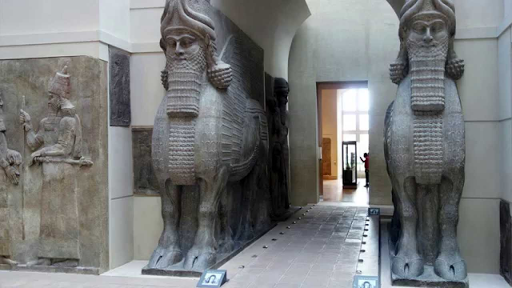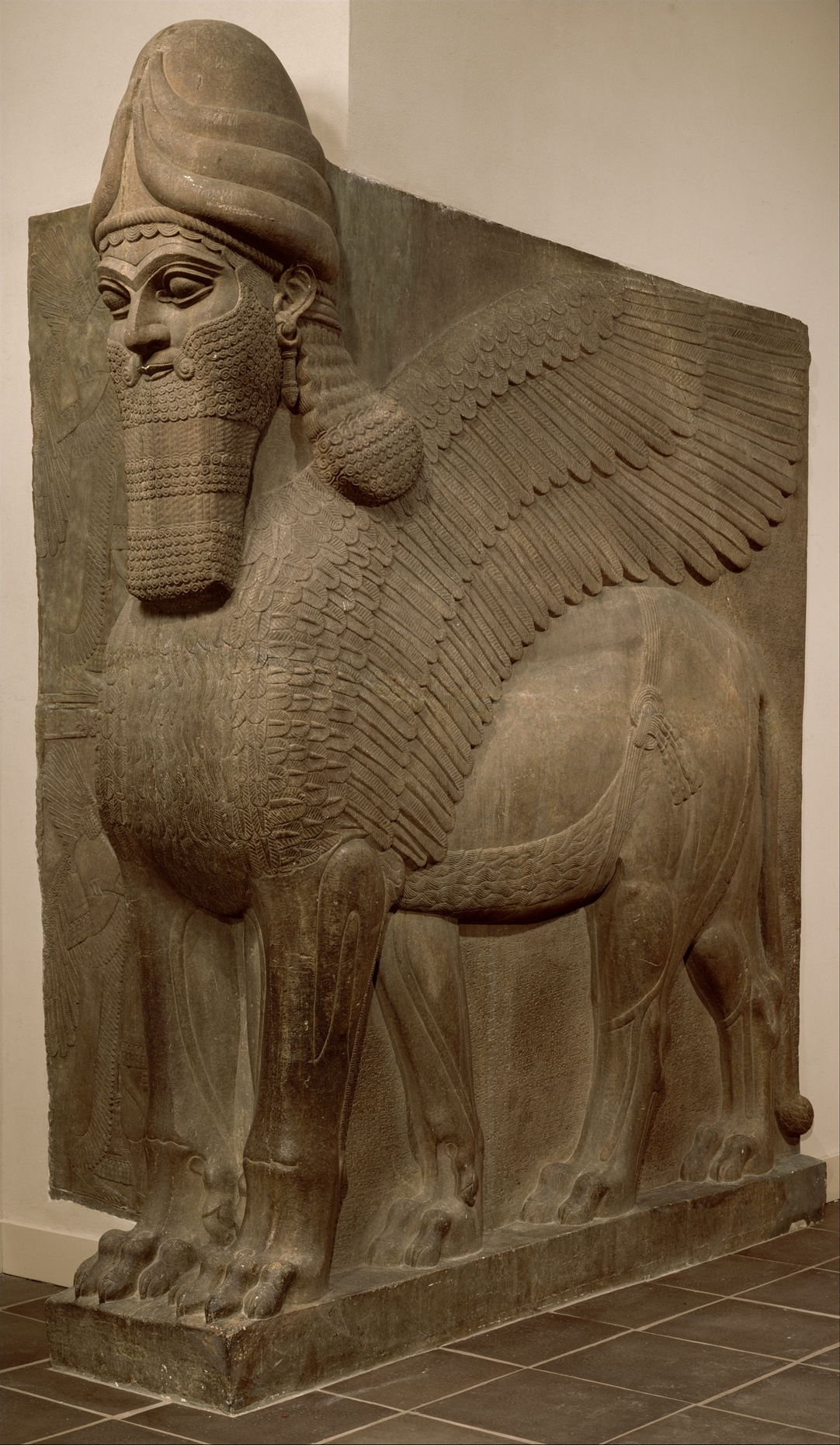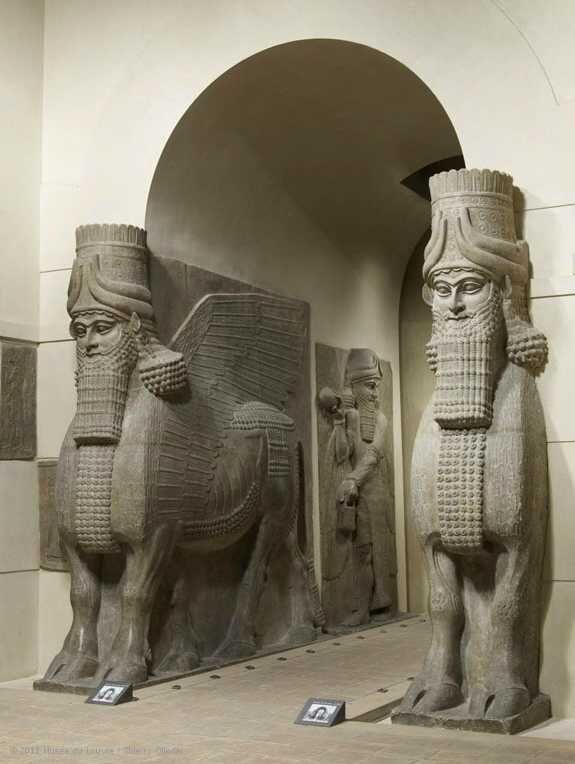Start studying Art History Studying. Learn vocabulary terms and more with flashcards games and other study tools.
Which is the oldest site for town planning.

. 883859 BC undertook a vast building program at Nimrud ancient Kalhu. Where were the lamassu sculptures originally displayed. 883-612 large monumental bulls often with wings and always with human heads were placed as gateway guardians at the entrances of royal palaces like Khorsabad and Nineveh.
Assyrian sculpture is the sculpture of the ancient Assyrian states especially the Neo-Assyrian Empire of 911 to 612 BC which ruled modern Iraq Syria and parts of Iran. And the lamassu which were thought of as protective deities stood guard either side of an entrance way. Furthermore where were the lamassu sculptures originally displayed.
From the ninth to the seventh century BC the kings of Assyria ruled over a vast Written By whitehouse March 07 2022 Add Comment Edit. Lamassu bull-man Lamassu. The Lamassu sculptures were recovered from where.
The most famous colossal statues of Lamassu have been excavated at the sites of the Assyrian capitals created. Where were the lamassu sculptures originally displayed. The Ziggurat at Ur was a fortress funerary monument palace temple platform Where were the Lamassu sculptures originally displayed.
721-705 BCE Part of a collection at the Louvre in Paris France. These sculptures were excavated by P-E. Human-headed winged lion lamassu ca.
To protect the household Lamassu were engraved in clay tablets and the tablet would then be buried under the doors threshold. What ethnic group is credited with the first system of writing known to man. A Sargons palace b Gudeas Lagash c Ashurbanipals palace d Ziggurat at Ur Which of the following played an important role in the shaping of modern art.
They have been thought to be very strong animals and functioned both as a clear reminder of the kings supreme authority and symbols of security for all people. The most famous colossal statues of Lamassu have been excavated at the sites of the Assyrian capitals established by King Assurnasirpal II reigned 883 859 BCE and King Sargon II reigned 721 705 BCE. The Assyrians envisioned a protective spirit that was part bull and part human and sometimes part eagle.
The first Lamassu appeared under Tiglath-Pileser in the 900s BCE. The Lamassu sculptures were recovered from where. The Assyrians came first.
The shelves on which the dead were placed in Early Christian catacombs were called. Human-headed Winged Lion is a raised relief sculpture of a Lamassu with the body of a lion made of gypsum alabaster. On view at The Met Fifth Avenue in Gallery 401.
In some cases the lamassu statues were accompanied by. In the Assyrian mythology there were human headed winged bullslions that were protective genies. The cultural landscape online textbook.
Landscape online textbook the. Diocletian and constantine paved the way for foreign invasion by dividing the empire creating administrative. Which work has a king approaching the god.
It comes from Mesopotamia and is believed to. Where were the Lamassu sculptures originally displayed. From what we can tell it seems that these sculptures were believed to protect the palace and king from evil supernatural forces as well.
The Lamassu seen from the side from the palace Sargon II r. Assyrian sculpture typically placed prominent pairs of lamassu at entrances in palaces facing the street and also internal courtyards. What were the most common themes in Assyrian art.
Lamassu are human-headed eagle-winged bulls or lions who once shielded cities in Mesopotamia. Looking up the lamassu that have been displayed in the. The first change was the capital was moved to Dur Sharrukin present day Khorsabad and second the Lamassu was presented on a bulls body compared to a lions and seems to be slightly smiling.
They were represented as double-aspect figures on corners in high relief. It forms a phase of the art of Mesopotamia differing in particular because of its much greater use of stone and gypsum alabaster for large sculpture. Sargons palace gudeas lagash ashurbanipals palace ziggurat at ur.
It was originally made for Hatshepsuts funerary temple at Deir el-Bahri which is a complex of temples dedicated to pharaohs of her family. Backstory The lamassu in museums today including the Louvre shown in our video as well the British Museum The Metropolitan Museum of Art and National Museum of Iraq in Baghdad and others came from various ancient Assyrian sites located in modern-day Iraq. These massive sculptures served as symbolic guards of Assyrian kings domain being placed at the entrance to both the city and palace gateways See Collins 2008 72.
The great Assyrian king Ashurnasirpal II r. From the ninth to the seventh century BC the kings of Assyria ruled over a vast empire centered in northern Iraq. An American professor named Michael Rakowitz was commissioned to recreate this Lamassu sculpture and it is now displayed in Trafalgar Square in London.
It is 164cm tall and 343cm long which is larger than an actual average lion. Much the best-known works are the huge lamassu guarding. Babylonian protective demon with a bulls body eagles wings and a human head.
Displayed originally where. The correct answer that would best complete the given statement above would be option b. On a larger scale Lamassu would also flank the entrances of palaces as colossal sculptures in high relief in pairs.
This replica was made with 10000 Iraqi date syrup cans and serves as a symbol of. Click to see full answer.

Lamassu Backstory Article Assyrian Khan Academy

Lamassu From The Citadel Of Sargon Ii Video Khan Academy
Colossal Lamassu Sculpture From The Palace Of Sargon Ii At Khorsabad Sargon Ii Google Arts Culture

Human Headed Winged Lion Lamassu Assyrian Neo Assyrian The Metropolitan Museum Of Art

25 Lamassu From The Citadel Of Sargon Ii Dur Sharrukin Modern Iraq Ap Art History

Lamassu History 2701 Wiki Fandom

Lamassu Symbol For Protection Indrosphere
Human Headed Winged Bull Lamassu Assyrian Neo Assyrian The Metropolitan Museum Of Art
0 comments
Post a Comment